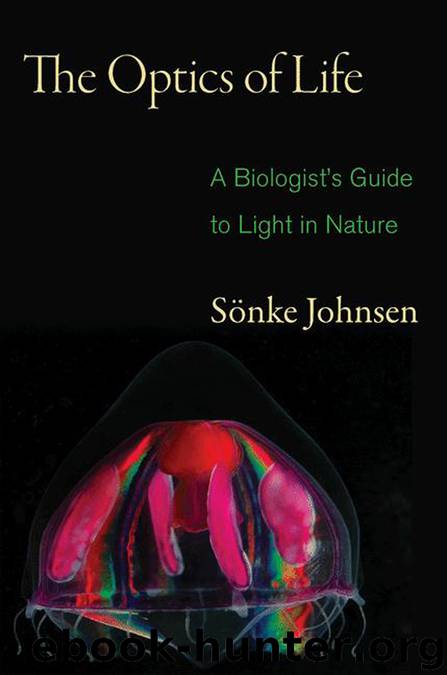The Optics of Life by Johnsen Sonke

Author:Johnsen, Sonke
Language: eng
Format: epub
ISBN: 9780691139913
Publisher: Princeton University Press
Figure 6.11: (Left) All the paths from S to P take the same amount of time, so there is strong constructive interference at P and the light passing through the lens is focused. From Feynman, 1988. (Right) Zone plate. The pathlength of light passing through each clear ring differs from that of light passing through the neighboring clear rings by exactly one wavelength, so the object behaves like a lens.
Biological lenses work just like human-made ones, but come in various types. Those found in the eyes of humans and many other terrestrial vertebrates are shaped like the classic magnifying-glass lens. Those found in aquatic vertebrates and cephalopods, though, are often spheres. This is because the large refractive-index difference between air and tissue gives the corneal surface of terrestrial animals a lot of refractive power. In fact over three-quarters of the refractive power of our eyes comes from our cornea, which is why the slight alterations achieved in LASIK and other corneal surgeries are so effective at fixing vision problems. However, the difference between the refractive indices of water and tissue are far less, so the corneas in aquatic animals function primarily as windows, leaving the lens to take on the primary job of refracting the light. The only way to do this without having a truly gigantic eye is to make the lens a sphere. However, one glance through a clear marble shows that a sphere is a terrible lens. Light passing through different parts of it are focused to entirely different places, a phenomenon known as “spherical aberration.” Aquatic animals solve this problem by smoothly changing the refractive index of their lens from a high value in the center to a low one near the periphery. The gradient can actually be quite steep, going all the way from 1.55 to just above 1.33, and has to be of just the right shape to work. Calculating the path through a graded-index lens is not as simple as calculating the path through a lens with one index and definitely departs from the idea that light is just bent at the surfaces. Remarkable as they are, graded-index materials appear to have evolved a number of times and are not found only in spherical lenses. They are also seen in the cylindrical lenses of the compound eyes of certain insects (e.g., scarab beetles [Caveney and McIntyre, 1981]) and in the tapered fiber optic cables of the Phronima eyes described above (Land and Nilsson, 2002).
Due to “diffraction,” small lenses, particularly those in the compound eyes of insects and crustaceans, run into trouble. They are so small that their ability to focus light is greatly limited by this spreading. So any animal with a compound eye that wants sharp vision needs to make the lenses larger, which quickly leads to enormous eyes. Compound eyes that could see as sharply as our actual human camera-like eyes would have to be one meter across (Land and Nilsson, 2002). This calculation accounts for the lower resolution of the
Download
This site does not store any files on its server. We only index and link to content provided by other sites. Please contact the content providers to delete copyright contents if any and email us, we'll remove relevant links or contents immediately.
Sapiens: A Brief History of Humankind by Yuval Noah Harari(13981)
The Tidewater Tales by John Barth(12391)
Mastermind: How to Think Like Sherlock Holmes by Maria Konnikova(6935)
Do No Harm Stories of Life, Death and Brain Surgery by Henry Marsh(6683)
The Thirst by Nesbo Jo(6432)
Why We Sleep: Unlocking the Power of Sleep and Dreams by Matthew Walker(6349)
Life 3.0: Being Human in the Age of Artificial Intelligence by Tegmark Max(5182)
Sapiens by Yuval Noah Harari(5117)
The Longevity Diet by Valter Longo(4856)
The Body: A Guide for Occupants by Bill Bryson(4578)
The Rules Do Not Apply by Ariel Levy(4520)
The Immortal Life of Henrietta Lacks by Rebecca Skloot(4248)
Why We Sleep by Matthew Walker(4190)
Animal Frequency by Melissa Alvarez(4148)
Yoga Anatomy by Kaminoff Leslie(4100)
The Hacking of the American Mind by Robert H. Lustig(4080)
All Creatures Great and Small by James Herriot(3980)
Barron's AP Biology by Goldberg M.S. Deborah T(3941)
Double Down (Diary of a Wimpy Kid Book 11) by Jeff Kinney(3921)
